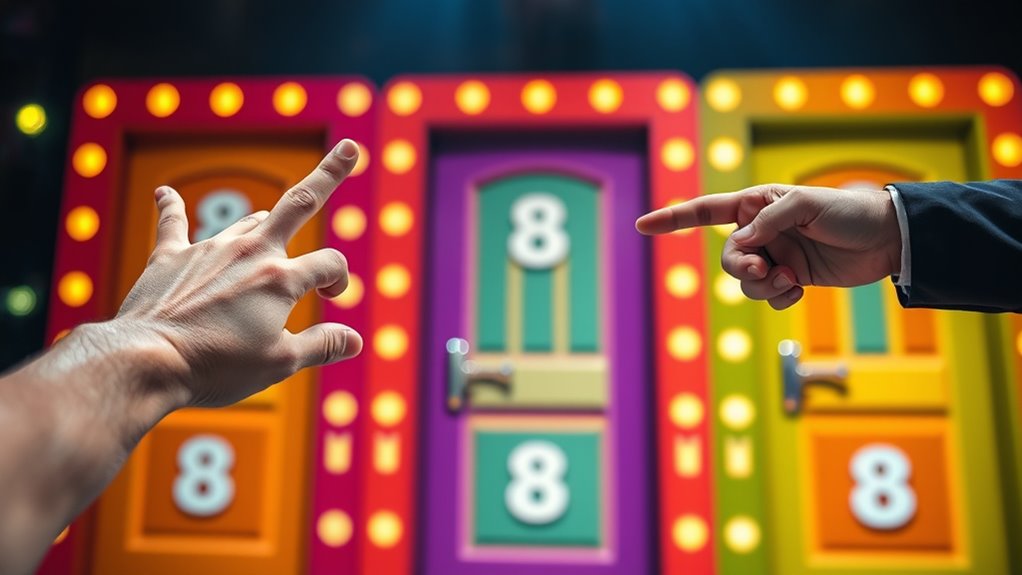The Monty Hall problem surprises many because switching doors after the host reveals a goat actually doubles your chances of winning, from 1/3 to 2/3, even though it feels counterintuitive. Initially, each door has an equal 1/3 chance, but Monty’s reveal is important information—it shifts probability in your favor if you switch. To fully understand why this works, there’s more to uncover that clears up the confusion and explains the logic behind it.
Key Takeaways
- Switching doors after Monty’s reveal increases winning odds from 1/3 to 2/3 due to initial probability distribution.
- Monty’s action provides crucial information, shifting the probability towards the remaining unopened door.
- The common intuition of a 50-50 chance after the reveal is incorrect; probabilities are skewed by initial choices.
- Properly understanding the problem requires recognizing how initial chances and new information impact outcomes.
- Always switching maximizes the chance of winning, illustrating how intuition can mislead in counterintuitive probability puzzles.

The Monty Hall Problem is a famous puzzle that challenges your intuition about probability and decision-making. At first glance, it seems straightforward: you pick one of three doors, hoping to find the prize behind it. But the twist comes after your initial choice. The host, Monty Hall, who knows what’s behind each door, opens another door that you didn’t choose, always revealing a goat. Now, he offers you the chance to switch your choice or stick with your original pick. Most people instinctively believe that switching doesn’t matter, thinking the odds are now 50-50. However, this is a common probability misconception that leads many astray.
The Monty Hall Problem reveals how intuition can mislead probability judgments and improve decision-making when understood correctly.
The key to understanding the puzzle is recognizing how your initial choice influences the overall probability. When you first pick a door, there’s a 1 in 3 chance you’ve chosen the prize and a 2 in 3 chance you’ve picked a goat. If your initial choice was wrong—which is more likely—you’re actually in a better position to switch after Monty opens a goat door. Because he always reveals a goat, the remaining unopened door after his reveal has a 2 in 3 chance of hiding the prize. This means your decision strategy should favor switching, as it doubles your chances of winning from 1/3 to 2/3.
Many people struggle with this because their intuition tells them the odds are equal once the host shows a goat. But this feeling ignores the underlying probabilities and the information gained from Monty’s action. Your initial choice had a low probability of being correct, and Monty’s reveal effectively consolidates the probability onto the remaining unopened door. Recognizing this shifts your perspective from a naive equal-chance assumption to a more accurate probabilistic understanding, which improves your decision strategy. Additionally, understanding the role of information in the problem is crucial to grasping why switching increases your odds of winning.
In practice, applying this knowledge means you should always switch after Monty reveals a goat, as it maximizes your chances of winning. This strategy isn’t just about luck; it’s about understanding how probability misconceptions can cloud judgment. By focusing on the initial probabilities and how Monty’s reveal provides additional information, you can make more informed decisions. The Monty Hall Problem demonstrates how intuition often conflicts with statistical reality, and embracing the correct decision strategy can lead to better outcomes. In essence, the puzzle serves as a compelling reminder to question your assumptions and analyze the situation with a clear understanding of probability.
Frequently Asked Questions
How Does the Monty Hall Problem Relate to Real-Life Decision-Making?
You see, the Monty Hall problem relates to real-life decision-making by highlighting how your risk assessment and strategic choices can be influenced by how options are presented. When you face choices, understanding the probability of outcomes helps you decide whether to switch or stay. It reminds you to think critically about your assumptions, and that sometimes, changing your approach can considerably improve your chances of success.
Can the Monty Hall Problem Be Applied to Other Probability Puzzles?
Yes, you can apply the Monty Hall problem to other probability puzzles, especially those involving paradox implications and game theory. It teaches you to question initial assumptions and consider how new information influences outcomes. By understanding these concepts, you’ll recognize similar patterns in decision-making scenarios, revealing hidden advantages or disadvantages. This insight helps you develop better strategies, whether in games, economics, or everyday choices, leveraging the problem’s core lessons.
What Are Common Misconceptions About the Monty Hall Problem?
You might believe that switching doors doesn’t change your chances, but this misconception myths often stem from intuition errors. Many think probabilities are equal after one door is opened, but in reality, the initial choice has only a 1/3 chance, while switching gives you a 2/3 chance of winning. Recognizing these intuition errors helps you understand why switching is the better strategy in the Monty Hall problem.
How Do Different Variations of the Puzzle Change the Odds?
Think of the puzzle as a game show maze where changing rules shifts your odds. Different variations, like Monty revealing a goat beforehand, influence the conditional probability and game show strategies you should use. For instance, switching doors often still offers a better chance, but if Monty’s choices change, the odds can shift, making your decision more or less advantageous. Adjust your strategy based on these subtle variations to maximize your winning chances.
Why Is the Monty Hall Problem Still Debated Among Mathematicians?
You’re probably wondering why the Monty Hall problem still sparks debate among mathematicians. It’s because it’s a classic probability paradox that challenges intuition and decision theory. While the odds favor switching doors, many find it counterintuitive, leading to ongoing discussions. Mathematicians debate the implications for understanding human decision-making and probability, making it a fascinating puzzle that reveals how our instincts can sometimes mislead us in complex situations.
Conclusion
Now, imagine standing at a game show, your heart pounding as you face three doors—one hiding a prize, two hiding nothing. You make your choice, then suddenly, Monty reveals an empty door. Would you stick or switch? The surprising truth is, switching doubles your chances, turning your gut instinct on its head. It’s a game of odds and illusions, where trust in intuition can lead you astray, revealing the fascinating complexity behind simple choices.









